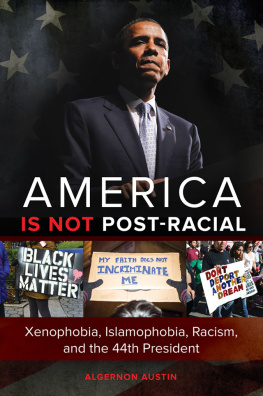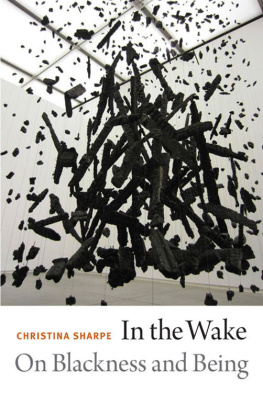Thank you for buying this ebook, published by NYU Press.
Sign up for our e-newsletters to receive information about forthcoming books, special discounts, and more!
Sign Up!
About NYU Press
A publisher of original scholarship since its founding in 1916, New York University Press Produces more than 100 new books each year, with a backlist of 3,000 titles in print. Working across the humanities and social sciences, NYU Press has award-winning lists in sociology, law, cultural and American studies, religion, American history, anthropology, politics, criminology, media and communication, literary studies, and psychology.
Achieving Blackness
NEW YORK UNIVERSITY PRESS
New York and London
www.nyupress.org
2006 by New York University
All rights reserved
Library of Congress Cataloging-in-Publication Data
Austin, Algernon.
Achieving blackness : race, Black nationalism, and Afrocentrism in
the twentieth century / Algernon Austin.
p. cm.
Includes bibliographical references and index.
ISBN-13: 978-0-8147-0707-4 (cloth : alk. paper)
ISBN-10: 0-8147-0707-6 (cloth : alk. paper)
ISBN-13: 978-0-8147-0708-1 (pbk. : alk. paper)
ISBN-10: 0-8147-0708-4 (pbk. : alk. paper)
1. Black nationalismUnited StatesHistory20th century.
2. AfrocentrismUnited StatesHistory20th century. 3. Black
MuslimsUnited StatesHistory20th century. 4. African
AmericansRace identityHistory20th century. I. Title.
E185.625.A97 2006
305.89607300904dc22 2005030046
New York University Press books are printed on acid-free paper,
and their binding materials are chosen for strength and durability.
Manufactured in the United States of America
c 10 9 8 7 6 5 4 3 2 1
p 10 9 8 7 6 5 4 3 2 1
Preface
I believe that I am acting in accordance with the will of the Almighty Creator by defending myself against the Jew, I am fighting for the work of the Lord.
Adolf Hitler
The above quotation is from Adolf Hitlers Mein Kampf. It was quoted on the website of the white supremacist organization, the Aryan Nations, in 2004. The racial ideology expressed by Hitler and contemporary white supremacist groups highlights the problems with the understanding of race used by many scholars today. Many scholars un-derstand racial ideologies as erroneous biological ideas about groups that can be distinguished by physical appearance. However, much white supremacist thought is based on religious, not biological, ideas. The Ku Klux Klan is a white Christian organization. The Christian Identity movement, which is linked to neo-Nazi organizations like the Aryan Nations, is, obviously, Christian also. The religious ideas of these organizations are heterodox, but they do not pretend to be scientific. Much white supremacist thought identifies Jews as a race although Jews are not physically distinguishable from non-Jews. White supremacist ideology does not fit comfortably within many scholars understanding of race as a biological pseudoscientific concept.
This mismatch between the scholarly conception of a racial ideology and peoples racial ideas is not limited to extremist groups. It is also present with regard to the racial ideas of more moderate Americans. Scholars have overemphasized the work of individual philosophers, naturalists, and scientists in studying racial ideology. Since race is socially created, we need to study social groups, not individual scholars. We need to examine how race is understood in social relations, not in a treatise.
While philosophers, naturalists, and scientists tend to place their racial ideas in a biological framework, average Americans tend to be less biologically minded and much more eclectic in their racial reasoning. Scholars have overestimated the power of science and secularism in popular thought. Many Americans are not convinced of biological evolution, for example. As numerous white supremacist organizations have shown, racial ideas are compatible with religious ones. One goal of this book is to bring about a reconceptualization of race so that the scholarly conception of race is a more useful and accurate one for studying social life. I use the racial ideologies of black nationalists to show that their racial ideas also draw on more than biological theories and that their racial categories are not always defined by differences in physical appearance.
This book addresses problems in the thinking of scholars who see race as socially constructed. While it does not directly address the errors in thinking that race is merely biology, these errors should become clear as one reads the book. To say that race is merely an acknowledgment of human biological differences is another way of abstracting the idea of race from social relations. The racial ideology of Nazi Germany, for example, was not mainly preoccupied with obvious physical differences. The Jewish population was not readily identifiable by appearance, which is why the yellow Stars of David were a useful means of identifying them. It would also be a complete misunderstanding of Nazism to assert that Nazism was about Tay-Sachs disease, because this disease is much more prevalent among European Jews than among other groups. Unfortunately, some recent discussions of race and medicine would lead one in this direction.
The discovery that the heart disease drug BiDil is effective specifically for black Americans has again raised the question of the relationship between biology and race for some. In November 2004, the New York Times journalist Nicholas Wade wrote about a special issue of Nature Genetics
The geneticists are aware of the fact that social definitions of race are not genetic definitions. How one is defined racially for social relations has never been based on a genetic test. In the United States, it has been possible for individuals with three white grandparents to be black. The way blackness is defined in the United States is not the way it is defined elsewhere. The fact that some social definitions of race are imperfectly correlated with some genes does not make race fundamentally about biology.
This book is the culmination of a very long process. Too many people have assisted me in too many ways for me to even attempt to list them all. I would like to single out a few people who have helped in this last stage of the project. Joseph P. McCormick, II allowed me to see an unpublished preliminary report from his survey of women attending the Million Woman March. Mary Ann Clawson, Roberta Gold, Lorelle Semley, and Dara Strolovich all provided useful comments on specific chapters. Mary OKicki helped me make the entire book clearer and better organized. Victoria Stahl and Allynn Wilkinson helped me prepare images for the text. I am grateful for all the help that I have received.
I am also grateful for permission to use material. A version of chapter 2 was previously published as Rethinking Race and the Nation of Islam, 19301975 in Ethnic and Racial Studies 26(1): 5269 (2003). Additional information about Ethnic and Racial Studies is available at http://www.tandf.co.uk/journals.
I am grateful to Third World Press for granting me permission to use Don L. Lee/Haki R. Madhubutis poem The New Integrationist in chapter 3. The poem was originally published in











